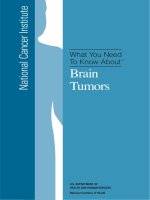Tài liệu What You Need To Know About - Brain Tumors ppt
Bạn đang xem bản rút gọn của tài liệu. Xem và tải ngay bản đầy đủ của tài liệu tại đây (575.16 KB, 51 trang )
National Cancer Institute
What You Need
To Know About
TM
Brain
Tumors
U.S. DEPARTMENT OF
HEALTH AND HUMAN SERVICES
National Institutes of Health
For more publications
This is only one of many free booklets for
people with cancer.
Here’s how to get other National Cancer
Institute (NCI) booklets:
• Call the NCI Contact Center
at 1–800–4–CANCER (1–800– 422–6237)
• Go to the NCI Web site at
/>For materials in Spanish
Here’s how to get NCI materials in Spanish:
• Call the NCI Contact Center
at 1–800–422–6237
• Go to the NCI Web site at
/>U.S. DEPARTMENT OF
HEALTH AND HUMAN SERVICES
National Institutes of Health
National Cancer Institute
Contents
About This Booklet 1
The Brain 2
Tumor Grades and Types 5
Risk Factors 8
Symptoms 9
Diagnosis 10
Treatment 13
Second Opinion 23
Nutrition 25
Supportive Care 25
Rehabilitation 26
Follow-up Care 27
Sources of Support 28
Taking Part in Cancer Research 30
Dictionary 31
National Cancer Institute Services 43
National Cancer Institute Publications 44
About This Booklet
This National Cancer Institute (NCI) booklet is
about tumors* that begin in the brain (primary brain
tumors). Each year in the United States, more than
35,000 people are told they have a tumor that started in
the brain.
This booklet tells about diagnosis, treatment, and
supportive care. Learning about medical care for brain
tumors can help you take an active part in making
choices about your care.
1
*Words in italics are in the Dictionary on page 31. The Dictionary
explains these terms. It also shows how to pronounce them.
This booklet is only about primary brain
tumors. Cancer that spreads to the brain from
another part of the body is different from a
primary brain tumor.
Lung cancer, breast cancer, kidney cancer,
melanoma, and other types of cancer commonly
spread to the brain. When this happens, the
tumors are called metastatic brain tumors.
People with metastatic brain tumors have
different treatment options. Treatment depends
mainly on where the cancer started. Instead of
this booklet, you may want to read the NCI fact
sheet Metastatic Cancer. The NCI Contact Center
at 1–800–4–CANCER (1–800 – 4 22–6237) can
send you this fact sheet, as well as other
information about metastatic brain tumors.
This booklet has lists of questions that you may
want to ask your doctor. Many people find it helpful to
take a list of questions to a doctor visit. To help
remember what your doctor says, you can take notes or
ask whether you may use a tape recorder. You may also
want to have a family member or friend go with you
when you talk with the doctor—to take notes, ask
questions, or just listen.
For the latest information about brain tumors,
please visit our Web site at />cancertopics/types/brain. Also, the NCI Contact
Center can answer your questions about brain tumors.
We can also send you NCI booklets and fact sheets.
Call 1–800–4–CANCER (1–800–422– 6237) or
instant message us through the LiveHelp service at
The Brain
The brain is a soft, spongy mass of tissue. It is
protected by:
• The bones of the skull
• Three thin layers of tissue (meninges)
• Watery fluid (cerebrospinal fluid) that flows
through spaces between the meninges and through
spaces (ventricles) within the brain
2
The brain directs the things we choose to do (like
walking and talking) and the things our body does
without thinking (like breathing). The brain is also in
charge of our senses (sight, hearing, touch, taste, and
smell), memory, emotions, and personality.
A network of nerves carries messages back and forth
between the brain and the rest of the body. Some
nerves go directly from the brain to the eyes, ears, and
other parts of the head. Other nerves run through the
spinal cord to connect the brain with the other parts of
the body.
Within the brain and spinal cord, glial cells surround
nerve cells and hold them in place.
3
Ventricles
(fluid filled)
Spinal cord
Brain
Meninges
Skull
Skull
Fluid between
the meninges
Brain
Fluid
This picture shows the brain and nearby structures.
The three major parts of the brain control different
activities:
• Cerebrum: The cerebrum uses information from our
senses to tell us what is going on around us and tells
our body how to respond. It controls reading,
thinking, learning, speech, and emotions.
The cerebrum is divided into the left and right
cerebral hemispheres. The right hemisphere controls
the muscles on the left side of the body. The left
hemisphere controls the muscles on the right side of
the body.
• Cerebellum: The cerebellum controls balance for
walking and standing, and other complex actions.
• Brain stem: The brain stem connects the brain with
the spinal cord. It controls breathing, body
temperature, blood pressure, and other basic body
functions.
4
Cerebrum
Cerebellum
Spinal cord
Brain stem
This picture shows the major parts of the brain.
Tumor Grades and Types
When most normal cells grow old or get damaged,
they die, and new cells take their place. Sometimes,
this process goes wrong. New cells form when the
body doesn’t need them, and old or damaged cells
don’t die as they should. The buildup of extra cells
often forms a mass of tissue called a growth or tumor.
Primary brain tumors can be benign or malignant:
• Benign brain tumors do not contain cancer cells:
—Usually, benign tumors can be removed, and they
seldom grow back.
—Benign brain tumors usually have an obvious
border or edge. Cells from benign tumors rarely
invade tissues around them. They don’t spread to
other parts of the body. However, benign tumors
can press on sensitive areas of the brain and
cause serious health problems.
—Unlike benign tumors in most other parts of the
body, benign brain tumors are sometimes life
threatening.
—Benign brain tumors may become malignant.
• Malignant brain tumors (also called brain cancer)
contain cancer cells:
—Malignant brain tumors are generally more
serious and often are a threat to life.
—They are likely to grow rapidly and crowd or
invade the nearby healthy brain tissue.
—Cancer cells may break away from malignant
brain tumors and spread to other parts of the
brain or to the spinal cord. They rarely spread to
other parts of the body.
5
Tumor Grade
Doctors group brain tumors by grade. The grade of
a tumor refers to the way the cells look under a
microscope:
• Grade I: The tissue is benign. The cells look nearly
like normal brain cells, and they grow slowly.
• Grade II: The tissue is malignant. The cells look
less like normal cells than do the cells in a Grade I
tumor.
• Grade III: The malignant tissue has cells that look
very different from normal cells. The abnormal cells
are actively growing (anaplastic).
• Grade IV: The malignant tissue has cells that look
most abnormal and tend to grow quickly.
Cells from low-grade tumors (grades I and II) look
more normal and generally grow more slowly than
cells from high-grade tumors (grades III and IV).
Over time, a low-grade tumor may become a high-
grade tumor. However, the change to a high-grade
tumor happens more often among adults than children.
You may want to read the NCI fact sheet Tumor
Grade.
Types of Primary Brain Tumors
There are many types of primary brain tumors.
Primary brain tumors are named according to the type
of cells or the part of the brain in which they begin.
For example, most primary brain tumors begin in glial
cells. This type of tumor is called a glioma.
Among adults, the most common types are:
• Astrocytoma: The tumor arises from star-shaped
glial cells called astrocytes. It can be any grade. In
adults, an astrocytoma most often arises in the
cerebrum.
6
—Grade I or II astrocytoma: It may be called a
low-grade glioma.
—Grade III astrocytoma: It’s sometimes called a
high-grade or an anaplastic astrocytoma.
—Grade IV astrocytoma: It may be called a
glioblastoma or malignant astrocytic glioma.
• Meningioma: The tumor arises in the meninges. It
can be grade I, II, or III. It’s usually benign (grade I)
and grows slowly.
• Oligodendroglioma: The tumor arises from cells
that make the fatty substance that covers and
protects nerves. It usually occurs in the cerebrum.
It’s most common in middle-aged adults. It can be
grade II or III.
Among children, the most common types are:
• Medulloblastoma: The tumor usually arises in the
cerebellum. It’s sometimes called a primitive
neuroectodermal tumor. It is grade IV.
• Grade I or II astrocytoma: In children, this low-
grade tumor occurs anywhere in the brain. The most
common astrocytoma among children is juvenile
pilocytic astrocytoma. It’s grade I.
• Ependymoma: The tumor arises from cells that line
the ventricles or the central canal of the spinal cord.
It’s most commonly found in children and young
adults. It can be grade I, II, or III.
• Brain stem glioma: The tumor occurs in the lowest
part of the brain. It can be a low-grade or high-grade
tumor. The most common type is diffuse intrinsic
pontine glioma.
You can find more information about types of brain
tumors at />types/brain. Or, you can call the NCI Contact Center
at 1–800–4–CANCER (1–800–422– 6237).
7
Risk Factors
When you’re told that you have a brain tumor, it’s
natural to wonder what may have caused your disease.
But no one knows the exact causes of brain tumors.
Doctors seldom know why one person develops a brain
tumor and another doesn’t.
Researchers are studying whether people with
certain risk factors are more likely than others to
develop a brain tumor. A risk factor is something that
may increase the chance of getting a disease.
Studies have found the following risk factors for
brain tumors:
• Ionizing radiation: Ionizing radiation from high-
dose x-rays (such as radiation therapy from a large
machine aimed at the head) and other sources can
cause cell damage that leads to a tumor. People
exposed to ionizing radiation may have an increased
risk of a brain tumor, such as meningioma or
glioma.
• Family history: It is rare for brain tumors to run in
a family. Only a very small number of families have
several members with brain tumors.
Researchers are studying whether using cell phones,
having had a head injury, or having been exposed to
certain chemicals at work or to magnetic fields are
important risk factors. Studies have not shown
consistent links between these possible risk factors and
brain tumors, but additional research is needed.
8
Symptoms
The symptoms of a brain tumor depend on tumor
size, type, and location. Symptoms may be caused
when a tumor presses on a nerve or harms a part of the
brain. Also, they may be caused when a tumor blocks
the fluid that flows through and around the brain, or
when the brain swells because of the buildup of fluid.
These are the most common symptoms of brain
tumors:
• Headaches (usually worse in the morning)
• Nausea and vomiting
• Changes in speech, vision, or hearing
• Problems balancing or walking
• Changes in mood, personality, or ability to
concentrate
• Problems with memory
• Muscle jerking or twitching (seizures or
convulsions)
• Numbness or tingling in the arms or legs
Most often, these symptoms are not due to a brain
tumor. Another health problem could cause them. If
you have any of these symptoms, you should tell your
doctor so that problems can be diagnosed and treated.
9
Diagnosis
If you have symptoms that suggest a brain tumor,
your doctor will give you a physical exam and ask
about your personal and family health history. You may
have one or more of the following tests:
• Neurologic exam: Your doctor checks your vision,
hearing, alertness, muscle strength, coordination,
and reflexes. Your doctor also examines your eyes to
look for swelling caused by a tumor pressing on the
nerve that connects the eye and the brain.
• MRI: A large machine with a strong magnet linked
to a computer is used to make detailed pictures of
areas inside your head. Sometimes a special dye
(contrast material) is injected into a blood vessel in
your arm or hand to help show differences in the
tissues of the brain. The pictures can show abnormal
areas, such as a tumor.
• CT scan: An x-ray machine linked to a computer
takes a series of detailed pictures of your head. You
may receive contrast material by injection into a
blood vessel in your arm or hand. The contrast
material makes abnormal areas easier to see.
Your doctor may ask for other tests:
• Angiogram: Dye injected into the bloodstream
makes blood vessels in the brain show up on an
x-ray. If a tumor is present, the x-ray may show the
tumor or blood vessels that are feeding into the
tumor.
10
• Spinal tap: Your doctor may remove a sample of
cerebrospinal fluid (the fluid that fills the spaces in
and around the brain and spinal cord). This
procedure is performed with local anesthesia. The
doctor uses a long, thin needle to remove fluid from
the lower part of the spinal column. A spinal tap
takes about 30 minutes. You must lie flat for several
hours afterward to keep from getting a headache. A
laboratory checks the fluid for cancer cells or other
signs of problems.
• Biopsy: The removal of tissue to look for tumor
cells is called a biopsy. A pathologist looks at the
cells under a microscope to check for abnormal
cells. A biopsy can show cancer, tissue changes that
may lead to cancer, and other conditions. A biopsy is
the only sure way to diagnose a brain tumor, learn
what grade it is, and plan treatment.
11
Surgeons can obtain tissue to look for tumor cells in
two ways:
—Biopsy at the same time as treatment: The
surgeon takes a tissue sample when you have
surgery to remove part or all of the tumor. See the
Surgery section on page 16.
—Stereotactic biopsy: You may get local or general
anesthesia and wear a rigid head frame for this
procedure. The surgeon makes a small incision in
the scalp and drills a small hole (a burr hole) into
the skull. CT or MRI is used to guide the needle
through the burr hole to the location of the tumor.
The surgeon withdraws a sample of tissue with
the needle. A needle biopsy may be used when a
tumor is deep inside the brain or in a part of the
brain that can’t be operated on.
However, if the tumor is in the brain stem or certain
other areas, the surgeon may not be able to remove
tissue from the tumor without harming normal brain
tissue. In this case, the doctor uses MRI, CT, or
other imaging tests to learn as much as possible
about the brain tumor.
12
Treatment
People with brain tumors have several treatment
options. The options are surgery, radiation therapy,
and chemotherapy. Many people get a combination of
treatments.
The choice of treatment depends mainly on the
following:
• The type and grade of brain tumor
• Its location in the brain
• Its size
• Your age and general health
For some types of brain cancer, the doctor also
needs to know whether cancer cells were found in the
cerebrospinal fluid.
13
A person who needs a biopsy may want to ask
the doctor the following questions:
• Why do I need a biopsy? How will the biopsy
results affect my treatment plan?
• What kind of biopsy will I have?
• How long will it take? Will I be awake? Will it
hurt?
• What are the chances of infection or bleeding
after the biopsy? Are there any other risks?
• How soon will I know the results?
• If I do have a brain tumor, who will talk with
me about treatment? When?
Your doctor can describe your treatment choices, the
expected results, and the possible side effects. Because
cancer therapy often damages healthy cells and tissues,
side effects are common. Before treatment starts, ask
your health care team about possible side effects and
how treatment may change your normal activities. You
and your health care team can work together to
develop a treatment plan that meets your medical and
personal needs.
You may want to talk with your doctor about taking
part in a clinical trial, a research study of new
treatment methods. See the Taking Part in Cancer
Research section on page 30.
Your doctor may refer you to a specialist, or you
may ask for a referral. Specialists who treat brain
tumors include neurologists, neurosurgeons, neuro-
oncologists, medical oncologists, radiation oncologists,
and neuroradiologists.
Your health care team may also include an oncology
nurse, a registered dietitian, a mental health counselor,
a social worker, a physical therapist, an occupational
therapist, a speech therapist, and a physical medicine
specialist. Also, children may need tutors to help with
schoolwork. (The Rehabilitation section on page 26
has more information about therapists and tutors.)
14
15
You may want to ask your doctor these
questions before you begin treatment:
• What type of brain tumor do I have?
• Is it benign or malignant?
• What is the grade of the tumor?
• What are my treatment choices? Which do you
recommend for me? Why?
• What are the expected benefits of each kind of
treatment?
• What can I do to prepare for treatment?
• Will I need to stay in the hospital? If so, for
how long?
• What are the risks and possible side effects of
each treatment? How can side effects be
managed?
• What is the treatment likely to cost? Will my
insurance cover it?
• How will treatment affect my normal
activities? What is the chance that I will have
to learn how to walk, speak, read, or write after
treatment?
• Would a research study (clinical trial) be
appropriate for me?
• Can you recommend other doctors who could
give me a second opinion about my treatment
options?
• How often should I have checkups?
Surgery
Surgery is the usual first treatment for most brain
tumors. Before surgery begins, you may be given
general anesthesia, and your scalp is shaved. You
probably won’t need your entire head shaved.
Surgery to open the skull is called a craniotomy.
The surgeon makes an incision in your scalp and uses a
special type of saw to remove a piece of bone from the
skull.
You may be awake when the surgeon removes part
or all of the brain tumor. The surgeon removes as much
tumor as possible. You may be asked to move a leg,
count, say the alphabet, or tell a story. Your ability to
follow these commands helps the surgeon protect
important parts of the brain.
After the tumor is removed, the surgeon covers the
opening in the skull with the piece of bone or with a
piece of metal or fabric. The surgeon then closes the
incision in the scalp.
Sometimes surgery isn’t possible. If the tumor is in
the brain stem or certain other areas, the surgeon may
not be able to remove the tumor without harming
normal brain tissue. People who can’t have surgery
may receive radiation therapy or other treatment.
You may have a headache or be uncomfortable for
the first few days after surgery. However, medicine can
usually control pain. Before surgery, you should
discuss the plan for pain relief with your health care
team. After surgery, your team can adjust the plan if
you need more relief.
16
You may also feel tired or weak. The time it takes to
heal after surgery is different for everyone. You will
probably spend a few days in the hospital.
Other, less common problems may occur after
surgery for a brain tumor. The brain may swell or fluid
may build up within the skull. The health care team
will monitor you for signs of swelling or fluid buildup.
You may receive steroids to help relieve swelling. A
second surgery may be needed to drain the fluid. The
surgeon may place a long, thin tube (shunt) in a
ventricle of the brain. (For some people, the shunt is
placed before performing surgery on the brain tumor.)
The tube is threaded under the skin to another part
of the body, usually the abdomen. Excess fluid is
carried from the brain and drained into the abdomen.
Sometimes the fluid is drained into the heart instead.
Infection is another problem that may develop after
surgery. If this happens, the health care team will give
you an antibiotic.
Brain surgery may harm normal tissue. Brain
damage can be a serious problem. It can cause
problems with thinking, seeing, or speaking. It can also
cause personality changes or seizures. Most of these
problems lessen or disappear with time. But sometimes
damage to the brain is permanent. You may need
physical therapy, speech therapy, or occupational
therapy. See the Rehabilitation section on page 26.
17
Radiation Therapy
Radiation therapy kills brain tumor cells with high-
energy x-rays, gamma rays, or protons.
Radiation therapy usually follows surgery. The
radiation kills tumor cells that may remain in the area.
Sometimes, people who can’t have surgery have
radiation therapy instead.
Doctors use external and internal types of radiation
therapy to treat brain tumors:
• External radiation therapy: You’ll go to a hospital
or clinic for treatment. A large machine outside the
body aims beams of radiation at the head. Because
cancer cells may invade normal tissue around a
tumor, the radiation may be aimed at the tumor and
nearby brain tissue, or at the entire brain. Some
people need radiation aimed at the spinal cord also.
18
You may want to ask your doctor these
questions about surgery:
• Do you suggest surgery for me?
• How will I feel after the operation?
• What will you do for me if I have pain?
• How long will I be in the hospital?
• Will I have any long-term effects? Will my hair
grow back? Are there any side effects from
using metal or fabric to replace the bone in the
skull?
• When can I get back to my normal activities?
• What is my chance of a full recovery?
19
The treatment schedule depends on your age, and the
type and size of the tumor. Fractionated external
beam therapy is the most common method of
radiation therapy used for people with brain tumors.
Giving the total dose of radiation over several weeks
helps to protect healthy tissue in the area of the
tumor. Treatments are usually 5 days a week for
several weeks. A typical visit lasts less than an hour,
and each treatment takes only a few minutes.
Some treatment centers are studying other ways of
delivering external beam radiation therapy:
—Intensity-modulated radiation therapy or
3-dimensional conformal radiation therapy:
These types of treatment use computers to more
closely target the brain tumor to lessen the
damage to healthy tissue.
—Proton beam radiation therapy: The source of
radiation is protons rather than x-rays. The doctor
aims the proton beam at the tumor. The dose of
radiation to normal tissue from a proton beam is
less than the dose from an x-ray beam.
—Stereotactic radiation therapy: Narrow beams of
x-rays or gamma rays are directed at the tumor
from different angles. For this procedure, you
wear a rigid head frame. The therapy may be
given during a single visit (stereotactic
radiosurgery) or over several visits.
• Internal radiation therapy (implant radiation
therapy or brachytherapy): Internal radiation isn’t
commonly used for treating brain tumors and is
under study. The radiation comes from radioactive
material usually contained in very small implants
called seeds. The seeds are placed inside the brain
and give off radiation for months. They don’t need to
be removed once the radiation is gone.
Some people have no or few side effects after
treatment. Rarely, people may have nausea for several
hours after external radiation therapy. The health care
team can suggest ways to help you cope with this
problem. Radiation therapy also may cause you to
become very tired with each radiation treatment.
Resting is important, but doctors usually advise people
to try to stay as active as they can.
Also, external radiation therapy commonly causes
hair loss from the part of the head that was treated.
Hair usually grows back within a few months.
Radiation therapy also may make the skin on the scalp
and ears red, dry, and tender. The health care team can
suggest ways to relieve these problems.
Sometimes radiation therapy causes brain tissue to
swell. You may get a headache or feel pressure. The
health care team watches for signs of this problem.
They can provide medicine to reduce the discomfort.
Radiation sometimes kills healthy brain tissue.
Although rare, this side effect can cause headaches,
seizures, or even death.
Radiation may harm the pituitary gland and other
areas of the brain. For children, this damage could
cause learning problems or slow down growth and
development. In addition, radiation increases the risk
of secondary tumors later in life.
You may find it helpful to read the NCI booklet
Radiation Therapy and You.
20
Chemotherapy
Chemotherapy, the use of drugs to kill cancer cells,
is sometimes used to treat brain tumors. Drugs may be
given in the following ways:
• By mouth or vein (intravenous): Chemotherapy
may be given during and after radiation therapy. The
drugs enter the bloodstream and travel throughout
the body. They may be given in an outpatient part of
the hospital, at the doctor’s office, or at home.
Rarely, you may need to stay in the hospital.
The side effects of chemotherapy depend mainly on
which drugs are given and how much. Common
side effects include nausea and vomiting, loss of
appetite, headache, fever and chills, and weakness.
If the drugs lower the levels of healthy blood cells,
you’re more likely to get infections, bruise or bleed
easily, and feel very weak and tired. Your health
care team will check for low levels of blood cells.
Some side effects may be relieved with medicine.
21
You may want to ask your doctor these
questions about radiation therapy:
• Why do I need this treatment?
• When will the treatments begin? When will
they end?
• How will I feel during therapy? Are there side
effects?
• What can I do to take care of myself during
therapy?
• How will we know if the radiation is working?
• Will I be able to continue my normal activities
during treatment?
• In wafers that are put into the brain: For some
adults with high-grade glioma, the surgeon implants
several wafers into the brain. Each wafer is about
the size of a dime. Over several weeks, the wafers
dissolve, releasing the drug into the brain. The drug
kills cancer cells. It may help prevent the tumor
from returning in the brain after surgery to remove
the tumor.
People who receive an implant (a wafer) that
contains a drug are monitored by the health care
team for signs of infection after surgery. An
infection can be treated with an antibiotic.
You may wish to read the NCI booklet
Chemotherapy and You.
22
You may want to ask your doctor these
questions about chemotherapy:
• Why do I need this treatment?
• What will it do?
• Will I have side effects? What can I do about
them?
• When will treatment start? When will it end?
• How will treatment affect my normal
activities?









